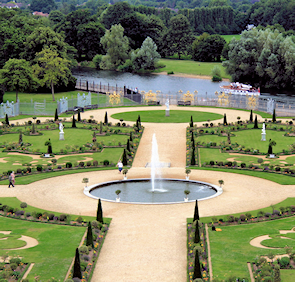Hampton Court
Hampton Court, Richmond upon Thames
A royal palace, park and gardens, set in a loop of the Thames, south of Bushy Park and Teddington

By 1066 Hampton manor existed as an important agricultural estate with royal connections. The Knights Hospitaller acquired it in 1236 and in 1338 the manor buildings consisted of a chamber block, hall, garden and church.
Tha manor was leased to Sir Giles Daubeney in 1494. He built a kitchen next to the hall, which survives as the Great Kitchen, and a courtyard and gatehouse.
Cardinal Wolsey took the lease from 1514 and extended the existing buildings with a second courtyard of lodgings, Base Court and the Great Gatehouse. He also added a gallery for viewing the garden, constructed a grand chapel and introduced lavish suites for the king and queen.
Henry VIII regularly used Hampton Court and by 1528 had made it his own. He extended the kitchens; built the Houses of Offices (the bakehouse and stores) and council chamber; rebuilt the chapel and great hall; constructed a system to bring drinking water from Coombe Hill in Kingston; and improved sanitation. The Great House of Easement, a lavatory block, could seat 28. Henry built new apartments for himself (Bayne Tower) and his queen, and provided for his entertainment with bowling alleys, tennis courts, a hunting park and gardens.

During the reign of James I, Hampton Court was the setting for a religious conference which led to the decision to publish the authorised version of the Bible commonly known as the ‘King James’ Bible.
The buildings changed little until the reign of William III and Mary II (from 1689), who commissioned Sir Christopher Wren to remodel the palace. New apartments were built overlooking a new privy garden, and the maze was planted. The full court was at Hampton Palace for the last time in 1737.
The palace was opened to the public in 1838 and went through a period of restoration. In 1986 a fire destroyed some of the king’s apartments; repairing the damage took six years. Hampton Court gardens attract over one million visitors a year and a flower show is held every July.
Hampton Court station and the surrounding residential area of that name are located on the other side of the Thames in the Surrey borough of Elmbridge.
The Impressionist painter Alfred Sisley was probably the greatest artist to have worked prolifically in the Hampton Court area, although he did not focus his attention on the palace itself. In a series of works painted in 1874, Sisley depicted the riverside, a regatta, the bridge across the Thames (from the side and below) and the road to and from Hampton Court.
